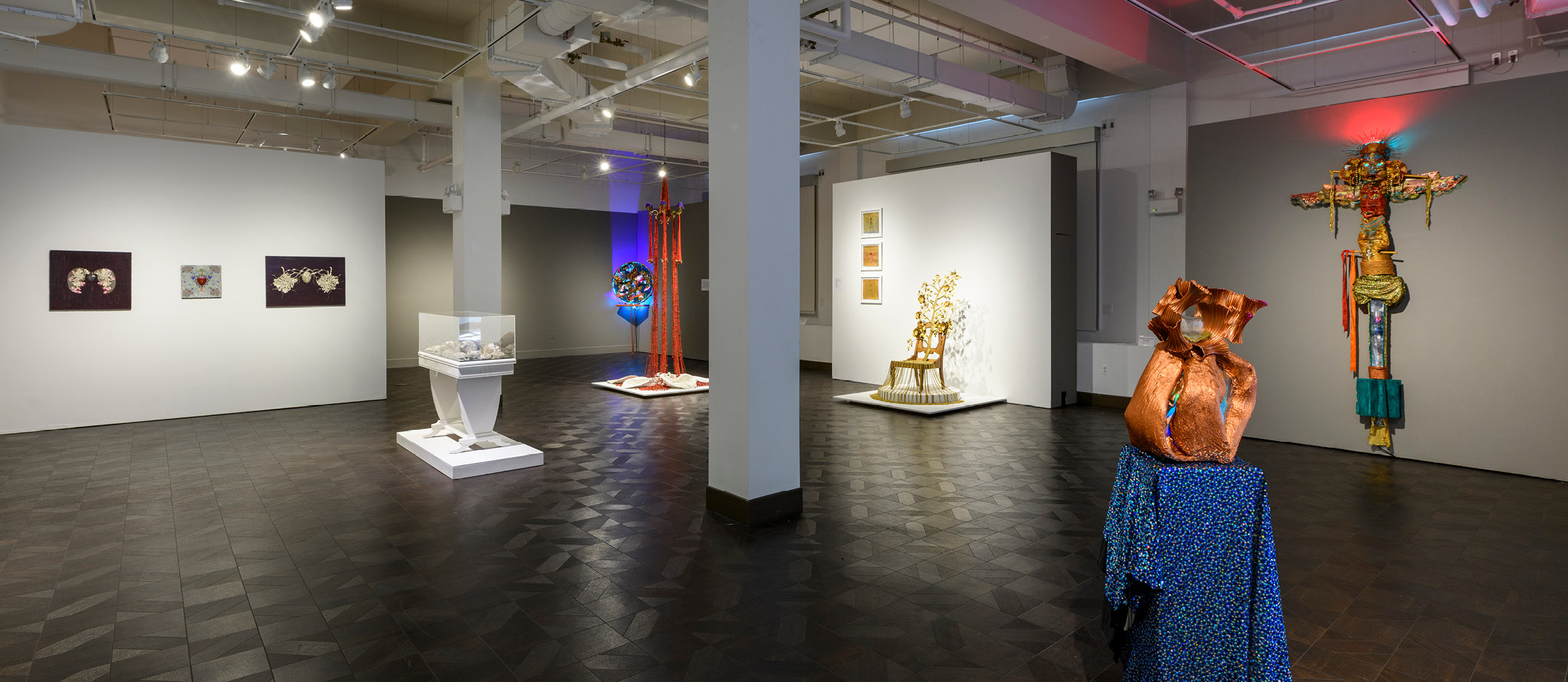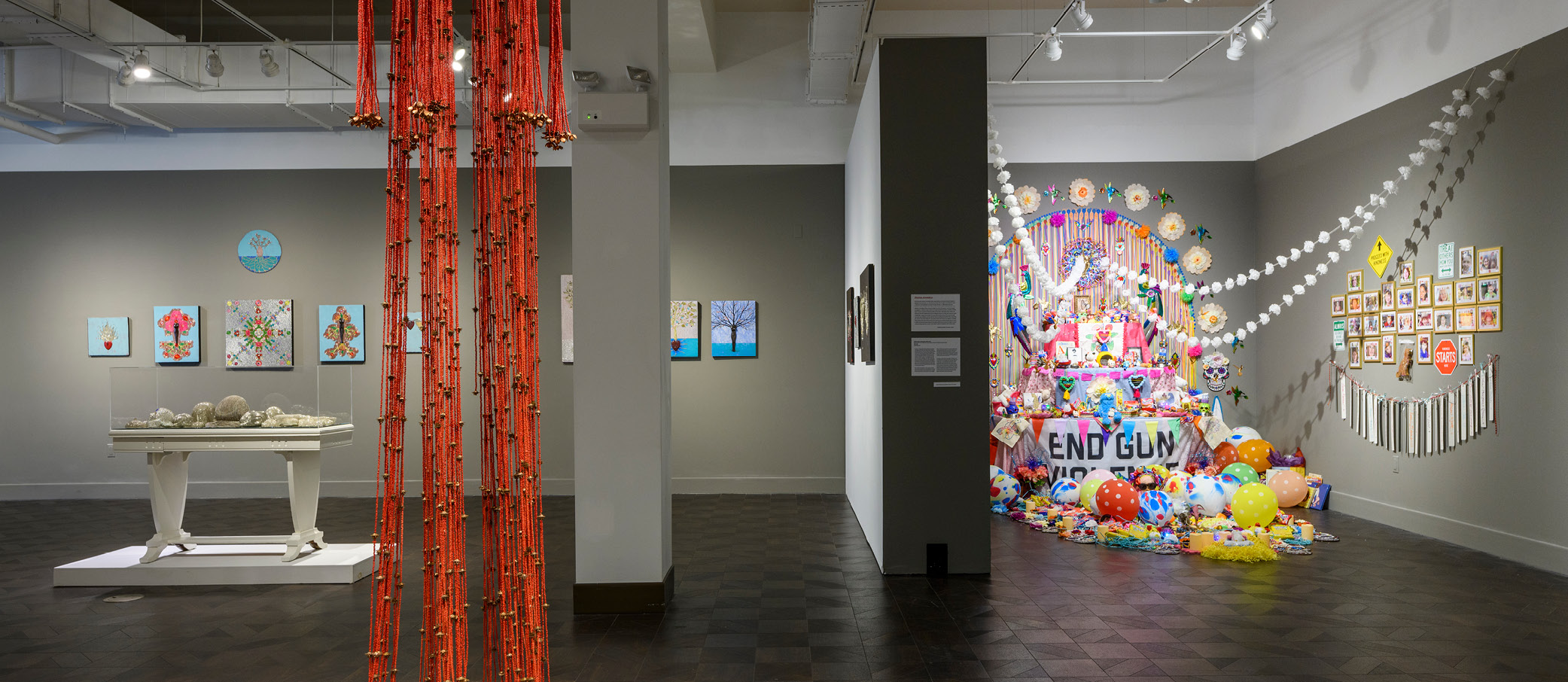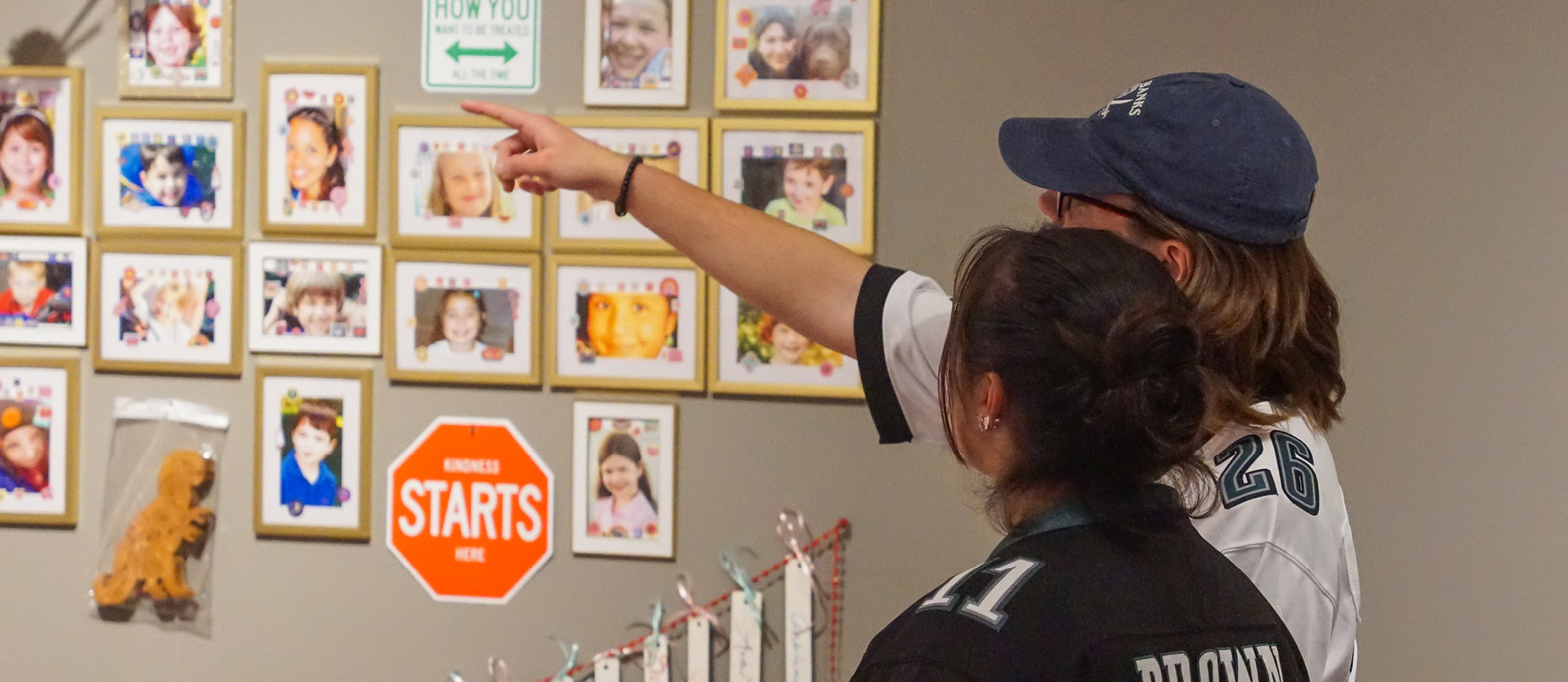Prima Materia
Prima Materia
Prima Materia: Blanka Amezkua, Esperanza Cortés, and Anthony Carlos Molden, curated by Anabelle Rodríguez-González
November 7, 2024 - January 4, 2025
301 High Street Gallery
Prima Materia brings together new and recent works by Blanka Amezkua, Esperanza Cortés, and Anthony Carlos Molden, three interdisciplinary artists working across a dynamic range of expressive forms, including but not limited to sculpture, painting, ceramics, musical and theatrical collaborations, performative actions, curatorial work, community interventions, site-specific installations, and public art commissions.
All three artists are experienced makers actively creating provocative artworks that relate to materials and techniques associated with crafts such as embroidery, beadwork, decorative paper folding and cutting, and elements from the scenic arts. Their efforts consistently yield marvelous results, including novel sculptural objects, sumptuously detailed and evocative two-dimensional works, and challenging mixed-media installations that appeal to the senses through their impressive individual and collective visuality.
Whether anchored on the wall or displayed in the round, the works selected for Prima Materia generate visual and spatial synergies imbued with a powerful combination of subtle yet vibrant energies and symbolic archetypes. Not unlike living entities, these works exert their agency upon us, in a sense “arresting” our sensorial attention through their ability to convey something tangible and concrete about the ephemeral and transcendental nature of the creative impulse.
Engaging with the alchemy of creativity through expertly crafted artworks, Prima Materia is essentially visionary in scope. Subsumed within the effervescent flow of macro and micro historical trends that have shifted the definition and reproduction of fine art worlds into supporting the creation and display of art that can be technically described as “craft-oriented” and vice versa, Prima Materia contributes to ongoing discourses around creative interdisciplinarity as a means to push and expand the collective vision of contemporary art in 2024. Each of the three artists has striven to diversify what art is and what it can be made of, into unique forms bounded by expressive materiality.
-Anabelle Rodríguez-González
Gallery Exhibition: Prima Materia, The Whit
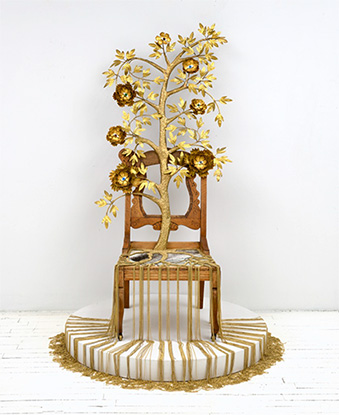
Esperanza Cortés
Esperanza Cortés develops multiple works in a series, moving between them over time. Depending on her evolving relationships with these works, this period of time can extend over years. To demonstrate this, the prolific and meticulous artist has graciously agreed to the loan of a significant number of works that represent this process. In particular, a group of smaller mixed-media works—including glass beadwork, encaustic, ceramic elements, and personal embroidery—are based on the meditative nature of repetition and a personal sense of internal rhythm, no doubt influenced by her talent for dancing. Her embodied experiences as a mother, dancer, and educator inform the lush complexity and sensuous character of her work. A triad of larger-format installations speaks to her interest in exploring the histories and devastating legacy of colonialism in the Global South, and in her native Colombia in particular (Gold Rush & Río Rojo). With Cortés as an active collaborator, Prima Materia exhorts its audience to contemplate the rampant degradation of the environment as ecocide and to share responsibility for mitigating the loss of our Indigenous ancestry resulting from the ongoing destruction of the cultural landscape of Abya Yala.
-Anabelle Rodríguez-González
Artist Statement
My birthplace, Colombia, profoundly impacts my artistic practice. It drives my interest and investigation of the art traditions, material culture, rituals, music, dance, medicine and lands of the Americas.
As a former Afro-Latin dancer and teacher, physicality informs my practice through body memory. My work seeks to underscore and use sacred space and the patterns of dance and percussion. I use music and fragments of histories as departure points to investigate and build the structure and space of the work.
My practice draws inspiration from my dance experience, and acts as a call and response to place, people, cultures, and histories. At the same time breaking down boundaries between painting, sculpture and installation, while addressing social justice, labor, cultural heritage, and environmental issues. Through the inclusion of ceramics, chains, glass beads, encaustic, embroidery and textiles, I reveal forgotten histories crucial to the understanding of the Americas. My work employs sculpture, painting, relief, installation, site-specific work, and video. I utilize a wide variety of materials and techniques, often in combination with reworked found objects impregnated with cultural symbols that act as sites of memory.
I highlight the cultural encounters that endlessly shape resistance while exploring the complexities of identity in the face of enduring colonization. My work aims to create an intimate repository for collective memory and implements the human body as a symbol and expression of nature, vulnerability, and power. My works are intricately crafted to encourage the viewer to reconsider social and historical narratives, especially when dealing with colonialism and raising critical questions about the politics of erasure and exclusion. Esperanza (hope) is a guiding force in the making of my work, which are improvisational constructions, infused with hope and renewal.
Biography
Esperanza Cortés is a Colombian-born multidisciplinary artist based in New York City. Cortés' inspiration for her art comes from the ebbs and flows of America and the American population, which encompasses traditional American folk tales as well as the transcultural experiences shared by minorities and immigrants. Cortés’ works encourage viewers to reconsider traditional narratives, especially when considering colonialism and its lasting effects, and to openly grapple with critical questions about the politics of erasure and exclusion.
Her art has been featured in exhibits across New York and abroad, including the Bronx Museum of Art, Queens Museum, El Museo del Barrio, MoMA PS1 and Socrates Sculpture Park in NYC. National exhibitions include Albright-Knox Gallery, Ogden Contemporary Arts, Turchin Center for The Visual Arts, Jonathan Ferrara Gallery, Corcoran Gallery of Art, Neuberger Museum of Art, and the Cleveland Art Museum.
She has received numerous awards and fellowships, including the New York State Council on the Arts Project Grant, Shortlist 2022 Creative Capital, John Simon Guggenheim Fellowship, Hispanic Society Museum and Library Artist Research Fellowship, BRIC Media Arts Fellowship, Lower Manhattan Cultural Council Grant, Joan Mitchell Foundation Painters & Sculptors Grant, Puffin Foundation Grant, New York State Biennial, Robert Rauschenberg Foundation, New York Foundation for the Arts and the Sustained Achievement in the Visual Arts Award.

Blanka Amezkua
A fervent justice seeker, community artivist, experimenter, and traveler, Amezkua’s trajectory rightfully aims for the stars. For Prima Materia, Amezkua has accepted a commission to create a reflective in situ installation in the form of a large ofrenda—an offering that honors her Mexican ancestry and expands the living vernacular tradition of altar-making that dates back millennia. The origins of these ofrendas predate the arrival of Europeans, and archaeological investigations continue to reveal evidence of complex devotional practices, including sacrificial objects meant to appeal to and placate deities and ancestors, depending on the context. The dedicatory ofrenda is brightly colored by the ubiquitous presence of toys, yet its purpose is grim: it supplicates—it begs us to consider the current state of crisis and loss of innocence through the massacring of children, and the collective trauma resulting from the lack of laws supporting gun control in the United States, the only country where such events occur regularly. The bright, shiny surfaces of the toys used to construct the ofrenda pose a troubled duality: they are meant to reflect and promote innocent play, yet that same strident shine somehow manages to expose a dehumanizing support for a social crisis rooted in a lack of compassion and common sense.
-Anabelle Rodríguez-González
Artist Statement
In 1959, the UN General Assembly adopted the Declaration of the Rights of the Child, which defines children’s rights to protection, education, health care, shelter, and good nutrition.
The Declaration served as a foundational document in the development of international law related to children's rights. It has influenced national legislation and policies around the world, guiding efforts to protect and promote the rights of children in diverse contexts. It is considered a precursor to the Convention on the Rights of the Child.
In 1989, world leaders made a historic commitment to the world’s children by adopting the United Nations Convention on the Rights of the Child. The Convention explains who children are, all their rights, and the responsibilities of governments. All the rights are connected, they are all equally important and they cannot be taken away from children. United Nations.org
This being the first invitation to create an altar and having been raised by a family from the state of Michoacán in Mexico, where Día de los Muertos holds deep significance, I accepted the opportunity with joy and a deep sense of responsibility.
Altars, or ofrendas, are created to honor and remember those who have passed away. When set up inside a home, they are often dedicated to deceased family members and friends. These altars are a central element of Día de los Muertos, both in Mexico and within Mexican-American communities. They serve multiple purposes, such as honoring, welcoming, guiding, and nourishing the spirits of the departed.
According to a John Hopkins study called Gun Violence in the United States 2022: Examining the Burden Among Children and Teens, firearms were the leading cause of death for children and teens ages 1-17, prematurely taking the lives of 2,526 young people in 2022.
We’ve lost too many children to gun violence, here and everywhere else. Recently the wars abroad show how callous we can be to life, to a child’s life. If we fail to protect them, what future are we shaping for us all?
My altar, or ofrenda, is dedicated to the children of Sandy Hook and Robb Elementary Schools. It honors their memory while seeking to raise awareness of the tragic injustice inflicted on these children, their families, loved ones, and friends.
Biography
Blanka Amezkua is an interdisciplinary artist, cultural promoter, educator, and project creator. Amezkua was born in Mexico City and earned her B.A. from California State University at Fresno.
Amezkua’s art focuses on identity and she draws heavily for her background as a Mexican-American artist. Themes that pop up frequently in her work include gender, race, power, and privilege. Space also plays an important role in her art; she has created several spaces to display art, including her own bedroom and living room.
While navigating a difficult period in her life, including the loss of her 9-year-old nephew Sebastian, Amezkua traveled frequently between New York City and Athens, Greece. During this period, Amezkua initiated an artist-run space in Athens named Fokianou 24/7, now Fokianou Art Space.
Amezkua has been featured in many exhibits including MoMA/P.S.1 Contemporary Art Center, The Bronx Museum of the Arts, Queens Museum, El Museo del Barrio, the Elizabeth Foundation for the Arts, San Diego Art Institute, Wave Hill Public Garden & Cultural Center, the Delaware Center for the Contemporary Arts, Art Base, Brussels among others.
She currently resides and works in New York City where she continues to work towards reshaping the ways museums and artists interact with another, and how artists can re-indiginize their practices. She is an active member of Running for Ayotzinapa 43.
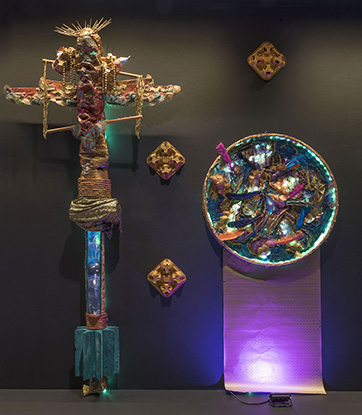
Anthony Carlos Molden
This exhibition reaches across time and space to the Italian modernists who brought the use of discarded common materials into the refined, elitist spaces of modern art. Prima Materia acknowledges the international legacy of the arte povera movement in the experimental character of Anthony Carlos Molden’s lighted sculptures. Molden’s body of work will forever be associated with his deep appreciation of music, including but not limited to genres with deep African American roots like jazz, funk, soul, house, and hip-hop. The material abundance provided by collecting discarded objects allows Molden to recombine their unique materialities like DNA, sampling them into novel assemblages. In this way, the sculptor has developed a sustainable artistic practice that supports his creative experimentation and practical versatility. His interest in a playful yet environmentally conscious praxis elicits a compassionate awareness that captivates the senses through enchanting and surprising permutations of light, texture, and color. While often encoding sobering themes and empowering concepts grounded in personal experience, his kinetic color assemblages delight, dazzle, and heal.
-Anabelle Rodríguez-González
Artist Statement
I make a holistic and literally regenerative art, symbolic in this by my repurposing of discarded materials, brought to new heights of appreciation when merged with paint and light.
Biography
Anthony Carlos Molden, born 1968 in Cedar Rapids IA and raised in Los Angeles, CA, is a mixed-media painter/sculptor. He currently resides and creates in Philadelphia, PA. Anthony is mostly self-taught, but in order to supplement self-learning, he has taken courses at both the Pasadena College of Art & Design and the University of Iowa. Anthony has been drawing since age three and vigorously painting with acrylic and oil since age twelve. In his twenties, he started working as a scenic designer on movie, video and theater sets. While living in New York City for 25yrs, Anthony has also had a career in construction as well as creation/restoration of decorative architecture.
All of the aforementioned experiences lent to the development of Anthony's current painting style. Anthony’s work is a mix of sculptural relief with a repurposing of found objects and recycled materials. All of his paintings are made with 90-100% recycled materials, including paint and surfaces. Anthony’s twenty year goal was to, "make something of value out of the piles of refuse around us everyday."
Anthony's work has been exhibited at reputable galleries such as Kenny Schacter Contemporary, La Mama La Galleria both in New York City as well as Philadelphia Galleries: the Painted Bride Art Center, Tiberino Museum and Rush Arts Gallery.
Mr. Molden has also become a master at live painting and has done it several times...from the renowned Leaf Art & Music Festival in Asheville, NC to the Kimmel Center in Philadelphia.
Image courtesy Philadelphia International Airport Exhibitions Program
Anabelle Rodríguez-González, curator
Anabelle Rodríguez-González is an arts practitioner, anthropologist, and educator from Puerto Rico based in Philadelphia. Her formal education includes dual undergraduate degrees in the visual arts and the history of art and architecture from Brown in consortium with RISD. After kicking off a peripatetic career as the inaugural director of the Museo de Arte de Ponce’s education programs and curator of exhibitions for cultural institutions in Philadelphia and New York City, she also completed additional master’s degrees in visual anthropology and the history of art and architecture focused on critical heritage studies. Her artwork has been exhibited in Austin, Philadelphia, Puerto Rico, and New York City, and “Globenesia” – a 2022-23 site-specific mixed-media installation dedicated to climate change – was recently featured in PBS.org. Anabelle’s curatorial praxis is constituted as a collaborative extension of her creative work, with dozens of exhibitions staged between the East Coast and Europe. Her most recent curatorial collaboration is Desde San Juan Bautista…, an official collateral event in this year’s 60th Venice Art Biennial and the first exhibition of contemporary art from Puerto Rico in the history of La Biennale as the oldest and most prestigious event of its kind in the world.

